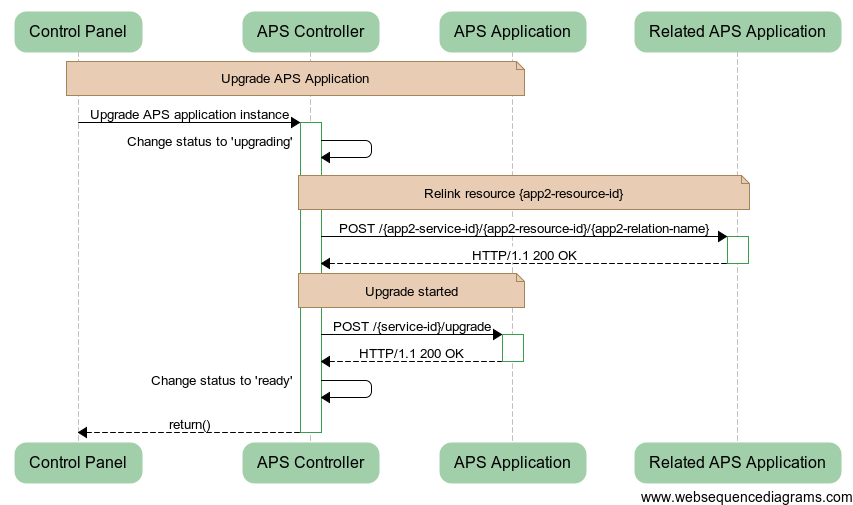Table Of Contents
Application Packaging Standard
Last updated 18-Mar-2019Upgrade¶
In this document:
Purposes¶
This document compiles all data related to the upgrade processes in APS applications. In the following table, you will find some cases when an APS application needs upgrade.
| Root Cause | Affected APS Components | Example |
|---|---|---|
| New service added | - New service declared in metadata
- New resource type
- New relations with existing types
- Provisioning logic of the new service
- New UI views and existing UI views
|
Subscription must include reference to allowed configurations (offers) |
| Business related resources must be able to get access to properties of each other | - New relation between resource types
- Permissions in resource types
- UI view
|
On the view presenting VPSes, server owner must be displayed
|
| New custom function added to a service | - Custom function in the resource type
- Provisioning logic of the service
- UI view that enables the feature to users
|
VPS owner is allowed to start and stop the VPS |
Note
APS application is uniquely identified by its ID as specified in package metadata. Upgrade process assumes using the same application ID in a current APS package and in APS packages that are updates of the current package.
Warning
Currently, APS does not support upgrade of packages from APS 1 to APS 2.
Versioning in APS¶
In APS packages, versions are assigned to the following components:
| Component | Example | Description | Influence on upgrade |
|---|---|---|---|
| APS specification | <application… version=”2.0”> | Defines package format | Note Described here application upgrade process is valid for APS 2 |
| Package version | <version>1.0</version>
<release>1</release>
VPS_Cloud-1.0-1.app.zip
|
- Application version
- Package release
- Package version combines both above
|
- Equals packaged application version
- Distinguishes packages with the same application version
- Must be updated before importing new package
Does not affect the upgrade process
|
| Type version | “id”: “http://…/vps/1.0” | Version of APS resources | Upgrades all resources based on the updated type |
Specification Version¶
APS version is specified in the root <application> element inside the APP-META.xml file, for example:
<application xmlns="http://aps-standard.org/ns/2" version="2.0">
This document is valid for APS version 2.x. Refer to Metadata Descriptor (APP-META.xml) for more details.
APS version is also specified in each type definition by means of the apsVersion property, for example:
{
"apsVersion": "2.0",
"name": "vps",
...
}
Package Version¶
Package version is specified by two elements in package metadata:
- The <version> element normally must correspond to the version of the packaged (integrated) application.
- The <release> element indicates a package release and is changed each time there is a need to update the package without changing the application version.
The package version contains both of the above elements in the form of {version}-{release}. With the following sample metadata
<application>
...
<version>2.0</version>
<release>6</release>
...
</application>
the package release would be 2.0-6.
Note
When importing an APS package, the APS controller expects the package version to be higher than any other package versions with the same application ID that are already stored in its package repository.
APS Type Version¶
Each schema in an APS package defines an APS type. Type ID contains the type version. In the following example, a type for VPSes is declared.
{
"apsVersion": "2.0",
"name": "vps",
"id": "http://aps-standard.org/samples/vpscloud/vps/1.0",
"implements": [
"http://aps-standard.org/types/core/resource/1.0"
],...
}
Type ID “http://aps-standard.org/samples/vpscloud/vps/1.0” contains its version - 1.0. If in a new package the type version is increased and the application instance is updated to the new package, then the APS controller will make all resources based on this type bound to its new version.
Among other types, each APS package must contain type definition for resources representing APS application instances. The type implements the core Application resource as in the following example.
{
"apsVersion": "2.0",
"name": "cloud",
"id": "http://aps-standard.org/samples/vpscloud/1.0",
"implements": [
"http://aps-standard.org/types/core/application/1.0"
],...
}
In the above definition, the type implements the core application resource type, whose ID is “http://aps-standard.org/types/core/application/1.0”. Thus, it declares itself as the type that must be used for provisioning an application instance through the root application service declared on an APS application endpoint. APS controller expects this service to accept the upgrade call during the upgrade process. In the above example, the type ID is “http://aps-standard.org/samples/vpscloud/1.0”, and the version is 1.0.
Each application instance in a hosting platform is upgraded independently. It means, different application instances can be based on different package versions. Thus, there is no restriction on having different versions of an APS type defined by different package versions on the same hosting platform.
Upgrade Strategies¶
Formal Upgrade Specification¶
To specify if a package can upgrade other packages of the same application, the <upgrade> meta element must contain an RQL statement identifying upgradable packages as explained later.
Major and Minor Upgrades¶
The version element in an APS type has the following structure: major[.minor]. Depending on the upgraded part, we call the upgrade correspondingly: major or minor.
Minor upgrades are backwards compatible BWCB. It means, after upgrade, there is no need to change type ID in existing requests for resources. For example, if a type was upgraded from http://www.odin.com/mailbox/1.0 to http://www.odin.com/mailbox/1.4, the APS controller will return the upgraded resource representation even if it receives the http://www.odin.com/mailbox/1.0 type in the request. The returned resource is bound to the new type version.
However the reverse, forward compatibility FWCB is not supported. For example, when APS type http://www.odin.com/mailbox/1.5 is requested, the APS controller will not return resources bound to http://www.odin.com/mailbox/1.4.
Different major versions are not compatible, that is http://www.odin.com/mailbox/1.0 and http://www.odin.com/mailbox/2.0 are two different non-compatible types.
The following examples illustrate the cases when you would better use minor upgrade and when major upgrade is necessary.
Example 1: Minor Upgrade¶
Initially there was a vps type containing a number of properties. Its version is 1.0.
{
"apsVersion": "2.0",
"name": "vps",
"id": "http://aps-standard.org/samples/vpscloud/vps/1.0",
...
"properties": {
"name": {
"type": "string",
},
...
}
}
The developer decided to add the optional property “description”. Since the property is not required, the resources will be backward compatible after the type upgrade. That is why, the developer decided to do minor upgrade to version 1.4, as follows.
{
"apsVersion": "2.0",
"name": "vps",
"id": "http://aps-standard.org/samples/vpsclouds/vps/1.4",
...
"properties": {
"name": {
"type": "string",
},
"description": {
"type": "string",
},
...
}
}
Example 2: Major Upgrade¶
Following up multiple requests from providers, the developer decided to make the “description” a required attribute. Evidently, the VPSes created earlier will not be compatible with the new type version, since they may do not have a description. That is why, the developer has to do a major upgrade, for example, to version 2.0 as follows.
{
"apsVersion": "2.0",
"name": "vps",
"id": "http://aps-standard.org/samples/vpsclouds/vps/2.0",
...
"properties": {
"name": {
"type": "string",
},
"description": {
"type": "string",
"required": true
},
...
}
}
Minor Upgrades of APS Types¶
In an APS type, there are three kinds of components that can be upgraded. The following upgrades of them are considered as minor.
-
- Adding weak (non-required) relations
-
- Adding optional (non-required) input parameters
-
Adding optional (non-required) properties
Changing attributes as specified in the table below:
Property attribute Minor upgrade name CANNOT be changed. type CANNOT be changed. required Change from false to true, only if the defaultvalue is specifiedreadonly Change from true to false final Change from true to false encrypted Change from true to false, only if required=falsedefault Can be changed format Can be changed, but it’s up to the developer to make sure that backwards compatibility of clients that may rely on the format will be kept, for example, change from ‘ip-address’ to ‘ipv4’ is safe, but not vice versa pattern Can be changed, but it’s up to developer to make sure that backwards compatibility of clients that may rely on the format will be kept title Can be changed description Can be changed minLength If decreased maxLength If increased minItems If decreased maxItems If increased uniqueItems Change from true to false enum Can be changed enumTitles Can be changed
Upgrade Procedure¶
To upgrade an APS application, it is necessary to update the APS package and then upgrade the application on the hosting platform in accordance with the workflow.
Developing Package Update¶
Generally, the procedure of updating a package resembles the package development steps, but it requires developers to do only those steps that make necessary updates. The following diagram presents candidates for update along with corresponding files and metadata.
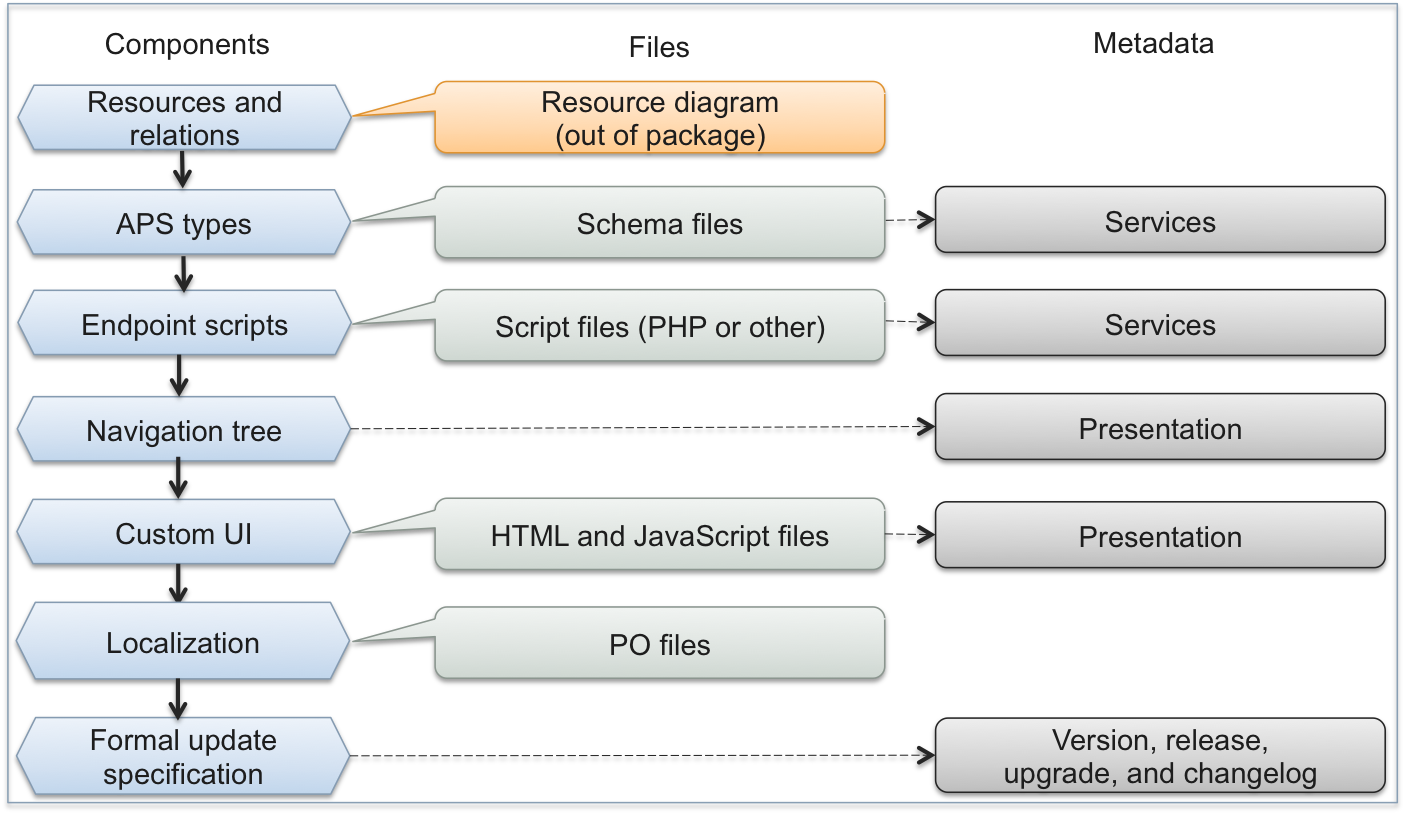
Correspondingly, the sequence of recommended steps looks as follows.
Draw the updated resource diagram, reflecting clearly major changes:
- Some types and respective services are added or deleted
- Relations are renamed, added, removed, or updated
Update APS types (types) to change the following:
- Add or delete properties
- Update attributes of properties
- Declare new custom operations or remove some of custom operations
- Update arguments of custom operations
Update provisioning logic of APS application endpoint:
- Create or update classes implementing services declared in metadata
- Create or update methods implementing operations declared in APS types
- Modify the
upgrade()method in the application root service
-
- Add or update navigation tree declaration in metadata
- Update UI scripts
Update localization and text translation:
- Add or update localization files
-
Update declaration of UI navigation
Add or remove declaration of some services
Warning
It is not possible to change the service ID declared in metadata, since it would look as if you removed a service and added a new one.
Increase package version
Specify the range of old packages that this package can upgrade
Updating Resource Diagram¶
It is necessary to draw a new resource diagram to clearly reflect the following updates:
- Adding or removing APS types
- Adding or removing links
- Changing link properties that make a link weak or strong, collection or singular
The example below indicates the following updates:
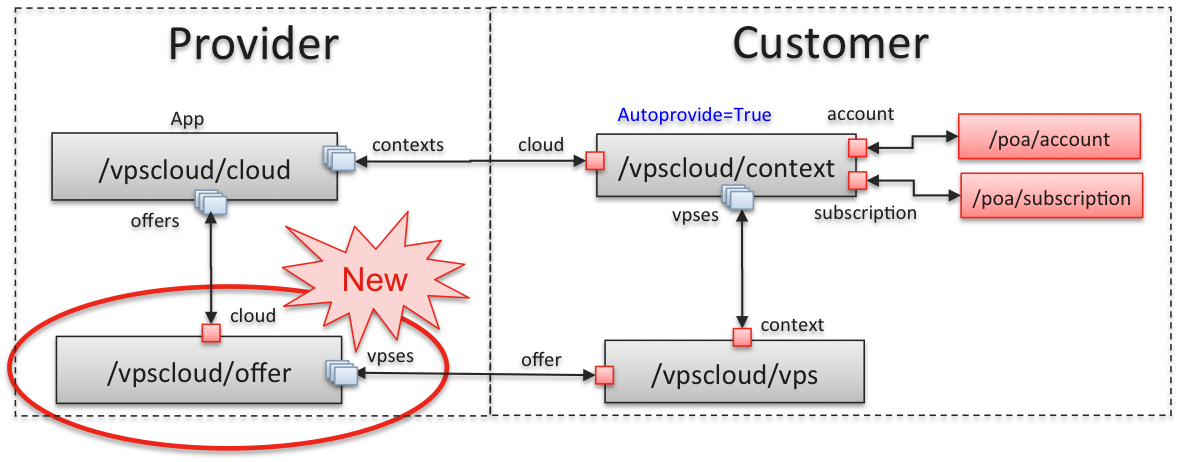
- A new APS type named offer appears.
- The new type will have two relations, cloud and vpses, with existing types.
- When updating the application, it is necessary to add new links to corresponding provisioned resources. It concerns cloud and vps resources.
Updating APS Type¶
An APS type can be updated in the following ways, each leading to declaration of a new type or a new type version as well as to updates in the provisioning logic on the APS application endpoint:
- Adding or removing types
- Adding or removing properties and operations
- Updating properties
- Updating operations
Note
1. When updating an APS type, the APS controller will bind the corresponding resources of the updated application instance to the new type version.
2. Each APS type is bound to its own application service. Thus, its update might require update of the service declaration in metadata as well as update of the service on the APS application endpoint.
Updating Provisioning Logic of Endpoint¶
Provisioning logic can be updated or fixed by updating provisioning scripts or other types of executables inside the APS package. Respective updates must be performed on the APS application endpoint.
Warning
APS controller refuses an update that requires removing a service if there are resources provisioned through it.
Updating Metadata¶
Updates described earlier may require update of metadata. The following list contains specifics of metadata updates.
- Package version should be increased. If the version of the packaged application was increased, then the <version> element in metadata should be increased accordingly, and it makes sense to reset the <release> element. Otherwise, only the <release> element should be increased.
- In the changelog, a new record should be added. It must reflect the changes in the package that help service providers make decision on application update.
- Variables specified in navigation trees require update if the versions of types they are referring were updated.
- Changes in application services, such as addition, removal, and renaming, require respective updates in metadata.
- To specify old packages that can be updated by this new package, the <upgrade> elements should be modified accordingly as described in the next section.
Upgrade Section¶
Package Matching¶
The <upgrade> section declares a range of previous package versions that the current package can upgrade.
Its match attribute defines this range by means of the version and release parameters.
It is possible to specify an exact package version or
a range of packages that can be updated by the new package. Therefore,
the match attribute contains an RQL expression that will be evaluated against metadata of the
installed packages with the same application ID.
Note
If the update specification is absent, the APS controller assumes that updates are not supported by the package at all.
For exact version comparison, the APS controller compares package versions as specified in the Package Version section of the specification with help of the =lt=, =gt=, =ge=, =gt=, =eq= and =ne= RQL operators.
In metadata, update statements define packages that can be updated as illustrated in the following examples.
Match exact package version. In the following example, the update is applicable for version 6.0-2.
<application> ... <upgrade match="version =eq= 6.0, release =eq= 2"/> .. </application>
Range of package versions. In the following example, the update is applicable for all versions starting from 1.0-0 and up to 2.0-7.
<application> ... <upgrade match="(version =ge= 1.0, version =lt= 2.0) or (version =eq= 2.0, release =le= 7)" /> ... </application>
Renaming Relations¶
The <upgrade> section allows changing relation names in APS types. For this purpose, the section includes <service> sections, one per each service (APS type). A <service> section contains the <rename> section with <relation> rename elements.
The following example illustrates how to rename two relations from their old names to the new names:
<upgrade match="version=ge=1.0">
<service id="offers" spec="version=eq=2.2">
<rename>
<relation new="servers" old="vpses"/>
<relation new="application" old="root"/>
</rename>
</service>
</upgrade>
Warning
In the above definition, it is not allowed to use concurrently the same name as new in one <relation> element
and as old in another.
The above example also illustrates how to specify the APS version that the system must support to apply the requested renaming.
Let us consider the following two major cases.
In package version 1.0, the vps type was linked to the user type through the myuser relation. In the new package version 1.1, the relation is renamed to user.
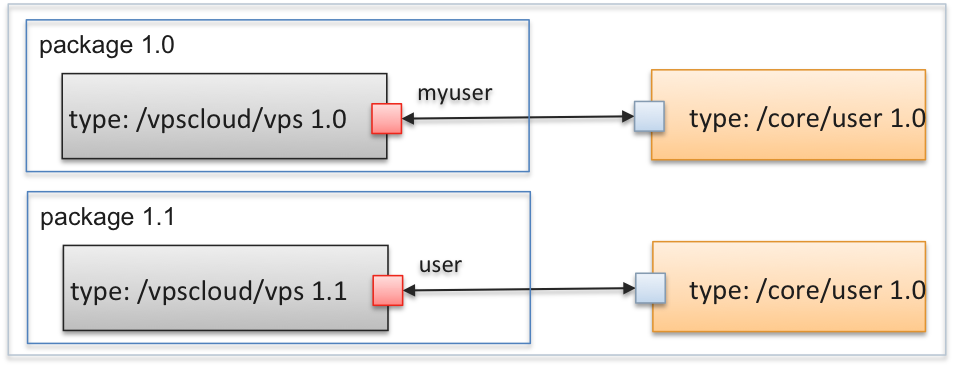
The new package must go through the following changes:
- In the vps schema definition, rename the myuser relation to user.
- Update the vps type version to 1.1.
- In metadata definition, specify the relation renaming: <relation new=”user” old=”myuser”/>
- Update the package version to 1.1.
In package version 1.0, the vps type was linked to the user type through the myuser link. In the next package version 1.1, the vps type implements the standard APS type user/service that has the user relation definition. It means, the vps type inherites the user link and there is no need in the old myuser relation.
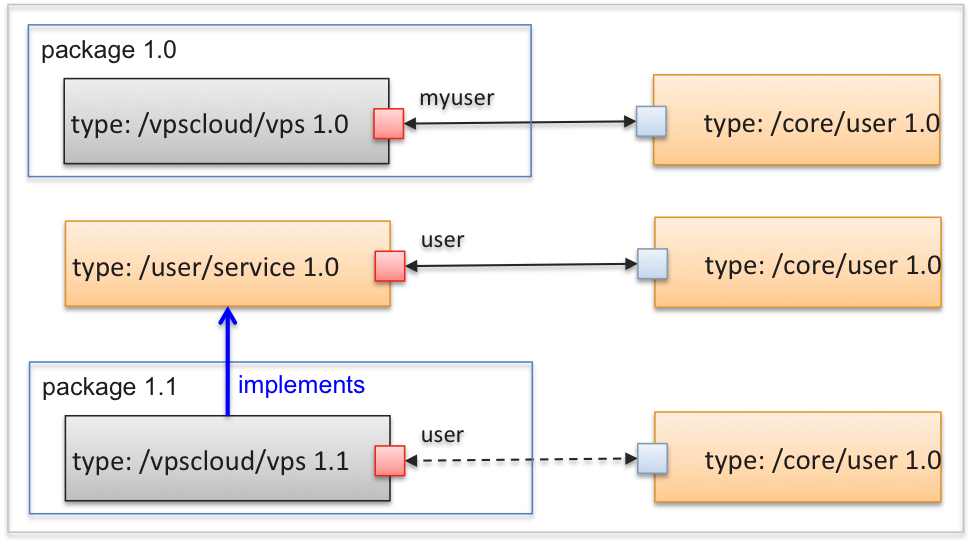
The new package must go through the following changes:
- Make the vps type implement the /user/service type.
- In the vps schema definition, remove the myuser relation.
- Update the vps type version to 1.1.
- In metadata definition, specify the relation renaming: <relation new=”user” old=”myuser”/>
- Update the package version to 1.1.
Updating User Interface¶
The following updates can be applied to custom UI.
- Updating Navigation tree in the <presentation> section of metadata.
- Adding, modifying, or deleting UI scripts in the
uifolder of the package.
Updating Text Translation¶
Update of text translation to different languages is the same as described in the Internationalization and Localization section of the APS specification.
Modifying Update Script¶
If APS application is to be updated, this update can be automated by modifying the upgrade method of the root appliation service. The method must await for its call from the APS controller.
Building Package¶
To build the updated package, use the APS build utility available in command line or embedded in the APS IDE. Pay attention to the package version that must be higher than the package versions to be updated.
Upgrade Workflow in Hosting Platform¶
Once an updated package is imported to the APS controller, an administrator of the hosting platform can initiate upgrade of an APS application instance to the new version of the package.
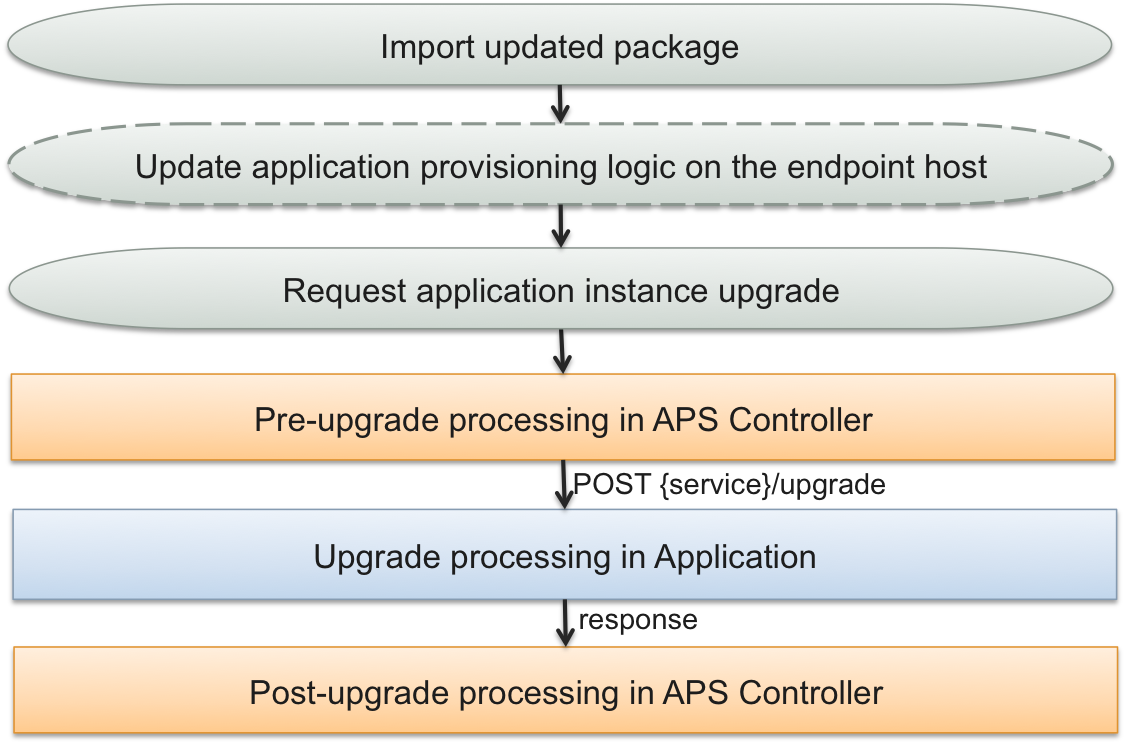
Once the new package is imported to the hosting platform, the provider staff can start upgrade of a selected application instance. Preliminary, they ensure:
- There are no failed tasks in the hosting platform related to the application being upgraded.
- The application provisioning logic, for example, PHP scripts, is updated on the endpoint host.
APS controller processes the upgrade internally and then calls the upgrade
method of the application root service (implementing the core application type) on the application endpoint.
The upgrade method is executed on the application side to bring the application resources in compliance
with the updated package. Once the application responded, the APS controller completes post-upgrade
operations.
Upgrades processed by APS Controller¶
Base Process¶
The aps.status property of the application resource indicates if the upgrade process is started as illustrated in the diagram:
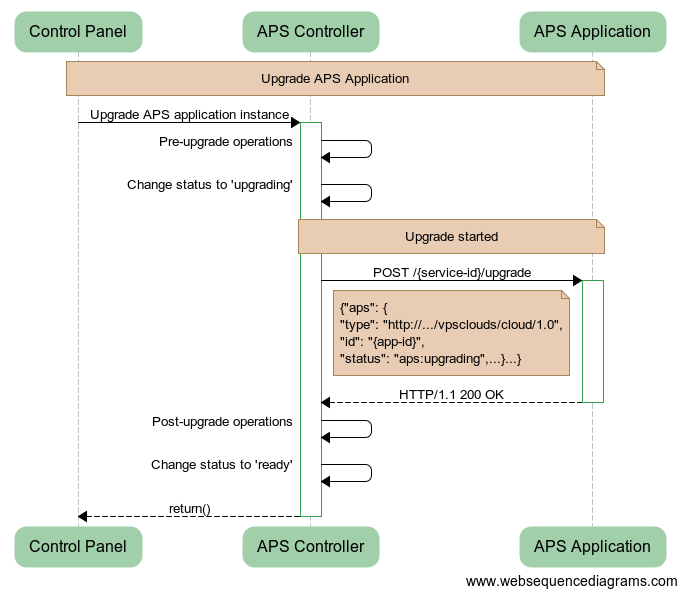
The upgrade process for a selected APS application instance is initiated from the control panel of the hosting platform. This makes the APS controller go through the following steps.
Switch the application resource status to upgrading.
Updates
aps.package.idin the application instance, thus binding the application instance to the new package.Call the upgrade method of the application resource and wait for the response. Application specific transfer from the current version to the new one must be done by the application instance itself. Potentially, this operation can be pretty long. The application instance can communicate with the APS controller to get, register, or change some application resources. This is the only period, when the application instance has access to both versions of APS types, the current one and the new one. In all its operations, the application should use the types updated by the new package, however the result depends on the operation:
- When getting (GET operation) a resource from the controller, the resource bound to the current type is returned.
- When creating (POST) or updating (PUT) a resource, the resource will be bound or re-bound to the new type.
Warning
It is not allowed to call a custom operation declared in an APS type whose version is being changed. If absolutely necessary, the application can schedule a separate post-upgrade task that will call the required custom operation, but the respective REST request must not use the same APS-Transaction-ID header as in the initial
upgradeoperation. The application can just omit the header in the request to make the APS controller generate a new one.Once the application completes its upgrade, perform internal post-upgrade operations. The goal is to ensure correct transfer of all APS resources to the new package with new type definitions. The APS controller achieves it by a number of validation operations.
- Verify if every required property is assigned a value. If there is a required property that is empty and no default value is specified in its APS type, complete the whole upgrade process with error message “Required property ‘x’ has no value”.
- Ensure proper links between resources:
- For each declared required relation, there is a link to a resource.
- Resources are linked with strong compliance with declaration of relations in APS types.
- Unregister all resources of the services that are dropped in the new package.
- Process major upgrades:
- Delete properties whose type must change, for example, CPU property was a number before upgrade, but must be an array of numbers after upgrade.
- Delete links based on relations that are missed in the new package.
- Process minor upgrades:
- Assign default values to upgraded or new properties that are required but not assigned a value.
Change status of the application resource to ready.
Upgrades processed by Application¶
Pre-Upgrade¶
An application developer may need to prepare the application to the upgrade process, for example, by updating the
upgrade method on the endpoint host and adding some auxiliary files. In such a case,
copy the updated application provisioning scripts to the application endpoint folder in accordance with
the second step in the update workflow.
Upgrade¶
The upgrade() method of the application resource defines the update activity on the
application side. This method is executed on the new, just upgraded, version of the application
installed on the endpoint host.
In fact it is the first call on the new code.
Note
- POST request must contain resource representation with old version in the body on input (from controller to application) and new version on output (from application to controller).
- If it is necessary to assign value to a new property, which is not defined in the old version of the APS type, the application must explicitly assign the resources to the new version of the type. This allows operating the new property.
Sample request:
POST /wordpress/80a4b75e-58a7-40e4-a148-dff560e5fa4a/upgrade
{
"aps": {
"type": "http://www.odin.com/web/wordpress/2.0",
"id": "80a4b75e-58a7-40e4-a148-dff560e5fa4a",
"package": {
"id": "b6d35786-8a3b-4931-8122-342aa2130320",
"href": "/aps/2/packages/b6d35786-8a3b-4931-8122-342aa2130320"
}
},
"admin_name": "admin",
"admin_email": "admin@example.com",
"title": [
"The test blog title1",
"The test blog title2"],
...
}
Response:
HTTP/1.1 200 OK
Note
- The application gets from the APS controller resources based on the old version of APS types.
- If it is necessary to assign value to a new property, which is not defined in the old version of the APS type, the application must explicitly reassign the resources to the new version of the type. This allows operating the new property.
When designing the upgrade method, the packager can define the following actions.
Update properties of all resources whose current properties do not match the new type. For this purpose, use:
- PUT /aps/2/application/{service-id}/{resource-id} to update resource properties
- POST /aps/2/application/{service-id} to register a new resource
Update new properties of the application instance (core application resource) assuming these properties are not defined in the old version of the application. When using PHP runtime, redefine these properties along with the APS type version as in the following example:
public function upgrade() { ... $this->newProp = "some value"; $this->aps->type = "http://mycompany.com/myapp/cloud/2.0"; ... }
Since versions 2.0-383, 2.1-302, and 2.2-115, PHP runtime updates the type automatically, before sending the result to the APS controller. So, you only have to change properties but not the type:
public function upgrade() { ... $this->newProp = "some value"; ... }
Update properties of resources that did not exist in the old types. It is possible only along with updating the resources to the new type. When using PHP runtime, it looks as in the following example that defines the new parameter1 property:
public function upgrade() { ... $apsc = \APS\Request::getController(); /* Here resources are still based on the old version */ $resources = $apsc->getResources("implementing(http://mycompany.example.com/myapp/srv-1/1.0)"); foreach ($resources as $resource) { /* We need to explicitly change resource APS type to the new one */ $resource->aps->type = "http://mycompany.example.com/myapp/srv-1/2.0"; /* Define the property as needed */ $resource->parameter1 = "some value"; /* Request the APS controller to apply both changes */ $apsc->updateResource($resource); } ... }
Since versions 2.0-383, 2.1-302, and 2.2-115, PHP runtime provides the getTypeByServiceId method to get the type version resource currently has, so you don’t have to specify the type explicitly. Also, PHP Runtime changes type version automatically in updateResource method, if it is called inside the
upgrademethod. So, the example can be changed to the following:public function upgrade() { ... $apsc = \APS\Request::getController(); /* Here resources are still based on the old version */ $resources = $apsc->getResources("implementing(".$this->getTypeByServiceId("vpses").")"); foreach ($resources as $resource) { /* Define the property as needed */ $resource->parameter1 = "some value"; /* Request the APS controller to apply changes */ $apsc->updateResource($resource); } ... }
Refer to upgrade with PHP runtime article.
Link and unlink resources to match the new types. Therefore, use:
- POST /aps/2/resources/{resource-id}/{relation} to link or re-link a resource {resource-id}
- DELETE /aps/2/resources/{resource1-id}/{relation}/{resource2-id} to unlink resources
